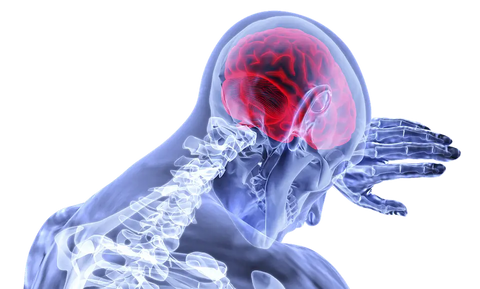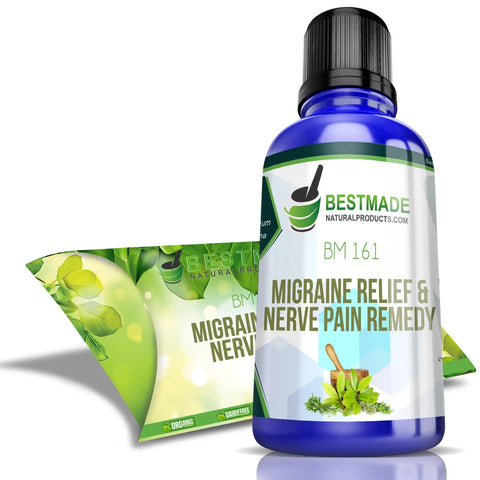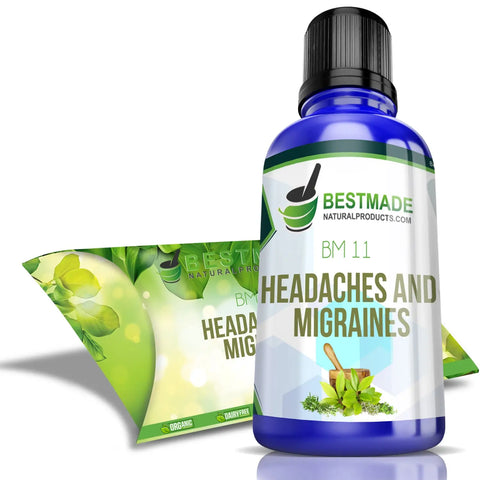
Headaches - Is Natural Relief Possible?
According to a study done by the World Health Organization, globally at least 50% of adults have at least one headache a year, but many of them have a lot more. Between 1.7% and 4% of the earth’s entire adult population have headaches 15 days a month; this is considered to be a chronic headache condition or a headache disorder. Unfortunately, these people suffer from headache symptoms, migraines, or tension headaches for about fifty percent of their lives! This is a very difficult way of living, so if you are one of these people, you should know that there are ways to prevent and relieve these symptoms.

Types of headaches
Did you know that there are 150 types of headaches? That is definitely more than a lot of people would expect. Although it’s a big number, some are more common than others. The following headache types are the most common:
- Tension headaches. These are the most common among adults and teens and are known to create mild to moderate pain that comes and goes over time. This type of headache has no other symptoms.
- Migraine headaches. This type often manifests as pounding, throbbing pain and lasts from 4 hours to 3 days, one to four times a month. Along with the pain, people experience other symptoms such as sensitivity to light, noise, or smells; nausea or vomiting, loss of appetite, and upset stomach. If your child has a migraine, he may look pale, have a fever and blurry vision, feel dizzy and maybe vomit.
- Cluster headaches. These are the most severe headaches. They come as an intense burning or piercing pain behind or around one eye. It can be throbbing or constant. This kind of pain is so strong that it wakes people from sleep and has them pace during an attack. On the side of the pain, your eyelid droops and reddens, the pupil gets smaller, or the eye makes tears. The nostril on that side runs or stuffs up. You might get these headaches one to three times per day during a cluster period which can last 2 weeks to 3 months. Each of these headache attacks lasts 15 minutes to 3 hours. It is possible for the headaches to disappear completely for months or years (remission), only to come back later. They are more common in men. Men are three to four times more likely than women to get them.
- Chronic daily headaches. People who suffer from this type of headache experience them for 15 days or more a month for longer than 3 months. They can either be short or last more than 4 hours. This one is usually one of the four types of primary headache: chronic migraine, chronic tension headache, new daily persistent headache, and Hemicrania continua.
- Sinus headaches. Sinus headaches bring a deep and constant pain to your cheekbones, forehead, or on the bridge of your nose. They happen when cavities in your head, called sinuses, get inflamed. So, the pain comes with sinus symptoms as well, like a runny nose, fullness in the ears, fever, and a swollen face.

- Posttraumatic headaches. These usually start 2-3 days after a head injury and may come for a few months. You will feel vertigo, lightheadedness, trouble concentrating, memory problems, a dull ache that gets worse from time to time, and irritability. If the pain doesn’t get better within a couple of weeks, you should go see your doctor.
Other less common headache types are:
- Exercise headaches. Whenever you’re active or afterward, whether the activity is exercise or sex, you may feel a pulsing pain on both sides of your head that can last from 5 minutes to 48 hours. This happens because when you’re active, the muscles in your head, neck, and scalp need more blood.
- Hemicrania continua. This is a chronic, ongoing headache that usually affects the same side of the face and head. It comes with symptoms like pain that varies in severity, red or teary eyes, runny or stuffy nose, contracted iris, and worse pain with drinking alcohol and physical activity. There are two types of hemicrania continua. It can be chronic, meaning you have daily headaches, or remitting, meaning you have headaches for 6 months that go away for a period of weeks or months and then come back.
- Hormone headaches. During your periods, pregnancy, and menopause your hormone levels shift and can cause headaches. Birth control pills and hormone replacement therapy are also headache triggers. When you get headaches 2 days before your period or in the first 3 days after it starts, they’re called menstrual migraines.
Headache pain comes from a mix of signals between your brain, blood vessels, and nearby nerves. Specific nerves in your blood vessels and head muscles switch on and send pain signals to your pain. Numerous things are supposed to cause common headaches. Some are more obvious than others. The obvious ones include:
- Stress. Emotional stress and depression cause headaches.
- When you take too much medication you can get headaches as a side effect.
- Infections, colds fevers, sinusitis, a throat infection, and ear infections can cause headaches.
- Hangovers. Alcohol use is a common headache cause.
- Your environment. Tobacco smoke, strong chemical smells, allergens, certain foods, pollution, noise, lighting, and weather changes are possible headache triggers.
- Headaches, especially migraine headaches, are usually genetic. If both of your parents suffer from migraines, there is a 70% chance you will too. If only one of your parents has a migraine history, the risk drops to 25%-50%.
- coughing
- sneezing
- dental work
- eating cold food
- eye strain
- muscle strain
- sexual activity
- traumatic experience
- premenstrual syndrome

Headache symptoms
Headaches can vary from mild pain to a debilitating migraine that can leave you sick for days. Depending on the type of headache, you could experience symptoms like:
- nausea
- vomiting
- eye pain
- neck pain
- dizziness
- light sensitivity
Headache Treatment

Common tension headaches are often treated with ibuprofen or acetaminophen both of which can cause side effects such as an upset stomach, nausea, vomiting, decreased appetite, and problems going to the washroom. Be aware not to overuse pain relief products as they can place a burden on your liver and kidney function.
People that get severe headaches like migraines are usually prescribed strong medications for treatment. Your doctor might prescribe you one of the following:
- NSAIDs - Nonsteroidal anti-inflammatory drugs are the most common drugs that are used to reduce the inflammation that accompanies arthritis. They are also used to reduce fevers and reduce headaches. The risks of this medication are gastrointestinal problems, a higher chance of getting a heart attack and stroke, allergic reaction, kidney problems, bruising, and bad interaction with other medicines meaning that they can increase or decrease the actions of other medicines.
- Barbiturates – Barbiturates are sedative-hypnotics, that are a type of central nervous system depressant frequently used to treat headaches, insomnia, and seizures. Side effects include drowsiness, low blood pressure, nausea, skin rash, fainting, hallucinations, and abnormally slow breathing.
Headache medication in general may have many side effects! In fact, some pain medications can even cause "overuse" headaches when they are taken too often. So, what can you do about it? First of all, you should only take medications with the approval of your doctor. Second, if you are worried about side effects, you can also choose other safer options, such as natural alternatives.
The good news is that there are a lot of natural alternatives and one, (or more), of them, might be just the right thing for your headache pain.
Natural relief of Headaches

Believe it or not, you have plenty of natural options that can help relieve your headaches; some of which you probably already know and others you probably never even thought about.
- Hot & Cold. You can put a cold pack or heating pad on the back of your neck or head to ease the symptoms of a tension headache. A cold pack to the forehead can help numb the pain of a migraine attack.
- Let Your Hair Down. Seriously, get rid of your ponytail, and take off that headband or hat to relieve pressure and ease the pain of an external compression headache.
- You can do this yourself, but it is even better if someone else eases away your tension by massaging your neck, shoulders, and temples. Some people find scalp massage is also effective for pain management. Adding essential oilsto your massage can enhance the benefits.
- Get Your Caffeine Fix. Caffeine is a stimulant drug and can actually be addictive, however, it also increases alertness and constricts blood vessels which can have a positive effect on headache symptoms.
- Relaxation Techniques. Yoga, meditation, and physical activity like hiking can have a positive impact on the frequency and intensity of your headaches. These changes can occur over time and keeping track of your headaches will help you recognize gradual changes; a daily log can be very useful in pinpointing and tracking patterns.
- Acupuncture is a 2000-year-old Chinese medical treatment where extremely thin needles are inserted into the skin at very specific spots to provide symptom relief. This one is a bit controversial as it is not 100% proven to be effective. Some people experience results, others don’t. Evidence of this treatment keeps being revealed. For instance, in January 2018 Harvard Health Publishingposted a blog with a great deal of evidence showing positive results of this treatment.
Certain plants, herbs, and even minerals can reduce headache symptoms.
Magnesium deficiency has been linked to migraine attacks. So, you can add broccoli and bananas to your diet as they are a great natural source of magnesium. If you want a relaxing way to absorb magnesium, try an Epsom salt bath - put 300 grams of Epsom salts in the tub; you can also add an essential oil like lavender which can be used to support headache relief. You will need to relax for 15-20 minutes in the tub for maximum absorption. You can also buy magnesium supplements but do your research first as you want to make sure you are buying a good quality supplement that is bioavailable.

Vitamin D deficiency might also play a role in frequent headaches. So, you should get outside and get moving, that would be a double bonus for both exercise and vit D at the same time. You can also take vitamin D supplements. Double-check that you are getting the correct dosage, you don't want to do more harm than good. According to the Mayo Clinic, the main consequence of vitamin D toxicity is a buildup of calcium in your blood (hypercalcemia), which can cause nausea and vomiting, weakness, and frequent urination.
Feverfew is a medicinal plant that grows in Balkan Mountains and it has been shown to help with the symptoms of migraines such as pain, sensitivity to light, and nausea. For best results, you will need to take this for about 1 month.
Of all these natural solutions, some will be more effective than others. You should check your options and see what works best for you.

Bottom line
Suffering from headaches is something that many people struggle with, unfortunately. And as you can tell after reading this blog, there are many types of headaches that come with different symptoms. You can then choose the type of treatment you want to follow, with the help of your doctor. Or choose natural solutions that can help reduce your symptoms and feel more relieved.




Leave a comment